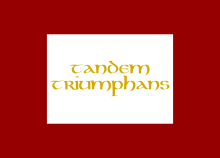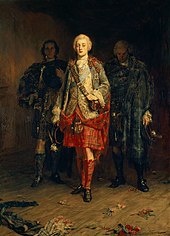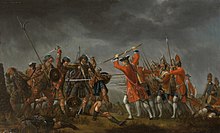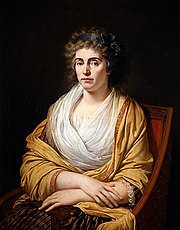By the way, my paternal grandfather, whose mixed up lineage included Poles, Germans and most likely Jews, loved the pretensions of what Faulkner called "Counts of no account."
This seemed to particularly come into play because of the pretensions of my father's mother's family, who were indeed descended from German-Polish aristocracy ( one of my father's cousins found the vaunted family estate, now in Poland --and used as a home from the aged but with an ancient groundskeeper who remembered something about the origins of the place).
To make this even more intriguing, some Welsh guys claiming to be descended from Bonnie Prince Charlie of Scotland and some woman named Sobieska (the female form of Sobieski) also ran around in the early 19th Century making a big deal about their royal lineage and even publishing a book on Tartans or something (they liked to wear kilts and Tartan gear, of course).
I find all of this more than somewhat amusing because even in this age their are people all over Europe who are obsessed with their aristocratic ancestries...
Lots of Americans buy into this too, buying "official" histories of their family names, often with coats of arms made up on plaques etc.
To show you how Byzantine this all is, here is an account of the Sobieskis from Wikipedia which will make you glad, if you are an American, that George Washington refused to be crowned King and thus we have been spared the same kind of tangled ancestor worship with titles and crests ( and baronial homes...which as I have said are better off being used as homes for the aged anyway)....
This starts with some of the Scottish story in full swing...Bonnie Prince Charlie figures in here somehow...
Prince Charles was born in the Palazzo Muti, Rome, Italy, on 31 December 1720, where his father had been given a residence by Pope Clement XI. He spent almost all his childhood in Rome and Bologna. He was the son of the Old Pretender, Prince James, son of exiled Stuart King, James II & VII and his wife Maria Clementina Sobieska and great-grandson of John III Sobieski, most famous for the victory over the Ottoman Turks in the 1683 Battle of Vienna.
His childhood in Rome was one of privilege, being brought up Catholic in a loving but argumentative family. Being the last legitimate heirs of the House of Stuart, his family lived with a sense of pride and staunchly believed in the Divine Right of Kings. The talk of regaining the thrones of England and Scotland for the Stuarts was a constant topic of conversation in the household, principally reflected in his father's often morose and combative moods.[4]
His grandfather, James II of England and VII of Scotland, had ruled the country from 1685 to 1689, at which time he was deposed when Parliament invited the Dutch Protestant, William of Orange and his wife the Princess Mary (King James' eldest daughter) to replace him, in the Revolution of 1688. James II had aimed to bring England back into the Catholic fold and, in the process, had irritated and alarmed the powerful statesmen of the day. Since the exile of James II, the 'Jacobite Cause' had striven to return the Stuarts to the thrones of England and Scotland, in 1707 united as Great Britain. Prince Charles Edward was to play a major part in the pursuit of this ultimate goal.
The young Prince was trained in the military arts from an early age. In 1734, he observed the French and Spanish siege of Gaeta, his first exposure to the art of war. His father managed to obtain the renewed support of the French government in 1744; and Charles Edward travelled to France with the sole purpose of commanding a French army, which he would lead in an invasion of England. The invasion never materialised, because the invasion fleet was scattered by a storm. By the time the fleet had regrouped, the British fleet had realised the diversion that had deceived them and had retaken their position in the Channel.[5] Undeterred, Charles Edward was determined to carry on in his quest for the restoration of the Stuarts.
The 'Forty-Five'
Main article: Jacobite rising of 1745
In December 1743, Charles's father named him Prince Regent, giving
him authority to act in his name. Eighteen months later, he led a rising
to restore his father to his thrones. Charles raised funds to fit out
two ships: the Elisabeth, an old man-of-war of 66 guns, and the Doutelle (le Du Teillay) a small frigate of 16 guns, which successfully landed him and seven companions at Eriskay
on 23 July 1745. Charles had hoped for support from a French fleet, but
it was badly damaged by storms, and he was left to raise an army in
Scotland.Having taken Carlisle, Charles's army progressed as far as Swarkestone Bridge in Derbyshire. Here, despite the objections of the Prince, the decision was made by his council to return to Scotland, largely because of rumours of a large government force being amassed. The Jacobites marched north once more, winning several more battles. The reports of a government army turned out to have been false, but Charles's retreat gave the English time to muster an actual army. The Jacobites were pursued by King George II's son, the Duke of Cumberland, who caught up with them at the Battle of Culloden on 16 April 1746.
Ignoring the advice of his best commander, Lord George Murray, Charles chose to fight on flat, open, marshy ground where his forces would be exposed to superior government firepower. Charles commanded his army from a position behind his lines, where he could not see what was happening. Hoping Cumberland's army would attack first, he had his men stand exposed to Hanoverian artillery. Seeing the error in this, he quickly ordered an attack, but the messenger was killed before the order could be delivered. The Jacobite attack, charging into the teeth of musket fire and grapeshot fired from the cannons, was uncoordinated and met with little success.
The Jacobites broke through the bayonets of the redcoats in one place, but they were shot down by a second line of soldiers, and the survivors fled. Cumberland's troops committed numerous atrocities as they hunted for the defeated Jacobite soldiers, earning him the title "the Butcher" from the Highlanders. Murray managed to lead a group of Jacobites to Ruthven, intending to continue the fight. However Charles, believing himself betrayed, had decided to abandon the Jacobite cause. James, the Chevalier de Johnstone, acted as Murray's Aide de Camp during the campaign and, for a brief spell, the Young Pretender's. He gives a first-hand account of these events in his "Memoir of the Rebellion 1745–1746".
Charles's subsequent flight has become the stuff of legend and is commemorated in the popular folk song "The Skye Boat Song" (lyrics 1884, tune traditional) and also the old Irish song Mo Ghile Mear by Seán Clárach Mac Domhnaill. Hiding in the moors of Scotland, he travelled about, always barely ahead of the government forces. Though many Highlanders saw Charles, and indeed aided him, none of them betrayed him for the £30,000 reward[6] offered. Assisted by such loyal supporters as the pilot Donald Macleod of Galtrigill, Colonel Con O'Neill, a Clanaboy O'Neill Prince of the O'Neill_dynasty [7] and Flora MacDonald, who helped him escape pursuers on the Isle of Skye by taking him in a small boat disguised as her Irish maid, "Betty Burke,"[8][9] he evaded capture and left the country aboard the French frigate L'Heureux, arriving back in France in September. The cause of the Stuarts now lost, the remainder of his life was — with a brief exception — spent in exile.
Exile

Clementina Walkinshaw, Charles' mistress from 1752 until 1760, and mother of his daughter Charlotte Stuart

Charlotte Stuart, Charles' daughter by Clementina Walkinshaw. Portrait by Hugh Douglas Hamilton, Scottish National Portrait Gallery
Charles lived for several years in exile with his Scottish mistress, Clementina Walkinshaw, whom he met, and may have begun a relationship with, during the 1745 rebellion. In 1753, the couple had a daughter, Charlotte. Charles's inability to cope with the collapse of the cause led to his problem with drink, and mother and daughter left Charles with James's connivance. Charlotte went on to have three illegitimate children with Ferdinand, an ecclesiastical member of the Rohan family. Their only son was Charles Edward Stuart, Count Roehenstart. Charlotte was suspected by many of Charles's supporters of being a spy planted by the Hanoverian government of Great Britain.[11]
After his defeat, Charles indicated to the remaining supporters of the Jacobite cause in England that, accepting the impossibility of his recovering the English and Scots crowns while he remained a Roman Catholic, he was willing to commit himself to reigning as a Protestant[citation needed]. Accordingly, he visited London incognito in 1750 and conformed to the Protestant faith by receiving Anglican communion, likely at one of the remaining non-juring chapels. Bishop Robert Gordon, a staunch Jacobite whose house in Theobald's Row was one of Charles's safe-houses for the visit is the most likely to have performed the communion, and a chapel in Gray's Inn was suggested as the venue as early as 1788 [Gentleman's Magazine, 1788]. This rebutted David Hume's suggestion that it was a church in the Strand.[12] Unusually, the news of this conversion was not advertised widely, and Charles had seemingly returned to the Roman Catholic faith by the time of his marriage.
In 1759, at the height of the Seven Years War, Charles was summoned to a meeting in Paris with the French foreign minister, the Duc De Choiseul.[13] Charles failed to make a good impression, being argumentative and idealistic in his expectations. Choiseul was planning a full-scale invasion of England, involving upwards of 100,000 men[14]—to which he hoped to add a number of Jacobites led by Charles. However, he was so little impressed with Charles, he dismissed the prospect of Jacobite assistance.[15] The French invasion, which was Charles's last realistic chance to recover the British throne for the Stuart dynasty, was ultimately thwarted by naval defeats at Quiberon Bay and Lagos.
In 1766, Charles's father died. Pope Clement XIII had recognised James as King of England, Scotland, and Ireland as "James III and VIII" but did not give Charles the same recognition.
In 1772, Charles married Princess Louise of Stolberg-Gedern. They lived first in Rome but, in 1774, moved to Florence where Charles began to use the title "Count of Albany" as an alias. This title is frequently used for him in European publications; his wife Louise is almost always called "Countess of Albany".
In 1780, Louise left Charles. She claimed that Charles had physically abused her; this claim was generally believed by contemporaries even though Louise was already involved in an adulterous relationship with the Italian poet, Count Vittorio Alfieri.[citation needed]
The claims by two 19th century charlatans—Charles and John Allen alias John Sobieski Stuart and Charles Edward Stuart—that their father, Thomas Allen, was a legitimate son of Charles and Louise are without foundation.[citation needed]
In 1783, Charles signed an act of legitimation for his illegitimate daughter Charlotte, born in 1753 to Clementina Walkinshaw (later known as Countess von Alberstrof). Charles also gave Charlotte the title "Duchess of Albany" in the peerage of Scotland and the style "Her Royal Highness", but these honours did not give Charlotte any right of succession to the throne. Charlotte lived with her father in Florence and Rome for the next five years.[citation needed]
Charles died in Rome on 31 January 1788. He was first buried in the Cathedral of Frascati, where his brother Henry Benedict Stuart was bishop. At Henry's death in 1807, Charles's remains were moved to the crypt of Saint Peter's Basilica in the Vatican where they were laid to rest next to those of his brother and his father. His mother is also buried in Saint Peter's Basilica.
When the body of Charles Stuart was transferred to Saint Peter's Basilica, his "praecordia" were left in Frascati Cathedral: a small urn encloses the heart of Charles, placed beneath the floor below the funerary monument.









No comments:
Post a Comment
Please leave a comment-- or suggestions, particularly of topics and places you'd like to see covered